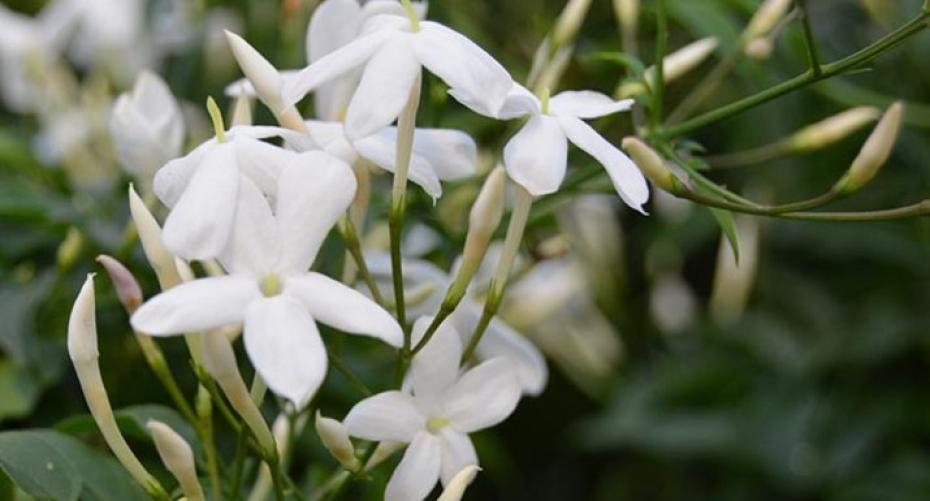Who can resist the heavenly scent and pure white flowers of Jasmine
The houseplant Jasmine polyanthum, commonly called Chinese Jasmine, is native to western China, and is one of a genus of 200 – 300 species, which can be evergreen or deciduous. The genus is native to the tropics of Africa, Asia and Australia. J. polyanthum can be evergreen or semi-evergreen. Given ideal conditions it can reach a height of 3m (10’), making it ideal for a warm conservatory. It has long slender pink tinged buds opening to a small, 2cm (.75”) across, starry white flower. Their chief attribute is their strong fragrance. They are fast-growing and will produce a succession of flowers over several weeks in late winter to early spring.
Position
A well-lit, warm position is essential. They are not suitable for growing outdoors in this country, so a south facing windowsill or conservatory would be ideal. They can withstand temperatures down to 0C (32F).
Planting
They need a fertile, well-drained compost so use good quality peat-free houseplant compost. Provide a frame of canes or train along wires. They are often sold trained around a hoop; they can be left like this or carefully unwound after flowering and trained around a larger structure.
Watering and Feeding
Keep just damp; letting the plant dry out will result in the buds going brown and failing to open. Feed fortnightly from spring to autumn with a balanced liquid fertiliser, then switch to a high potash feed, such as Tomorite.
Aftercare
Cut out any old wood. Wind in any new growth; if it becomes too tall and straggly, just cut back to a manageable size. Deadhead regularly to encourage repeat flowering. Re-pot after flowering when the pot is full of roots. The plant needs a period of cool temperatures to form flowers so move to a cool position in autumn.
Propagation
Propagation is by taking semi-ripe cuttings in late summer. Take cuttings about 7.5cm (3") and place in a mixture of good quality potting compost mixed with grit or Perlite, to open up the structure and make it well draining. Cover the pot with a plastic bag, putting canes around the edge of the pot to keep the plastic from touching the cuttings. Keep somewhere bright and warm for about 4 - 6 weeks when they should have formed roots. Take the bag off and grow on until the roots have filled the pots.
Pests and diseases
They are generally disease free, but can be susceptible, like most houseplants, to aphids, blackfly, woolly aphid and red spider mite.




![Kingsbury-bench-05[1].jpg](http://www.hayesgardenworld.co.uk/cdn/shop/files/Kingsbury-bench-05_5B1_5D.jpg?v=1712162737&width=1500)
![Kingsbury-bench-01[1].jpg](http://www.hayesgardenworld.co.uk/cdn/shop/files/Kingsbury-bench-01_5B1_5D.jpg?v=1712161065&width=1500)
![tw17a-4947_0[1].jpg](http://www.hayesgardenworld.co.uk/cdn/shop/files/tw17a-4947_0_5B1_5D.jpg?v=1712161495&width=1500)
![tw17a-4947_tenbury_5ft[1].jpg](http://www.hayesgardenworld.co.uk/cdn/shop/files/tw17a-4947_tenbury_5ft_5B1_5D.jpg?v=1712161172&width=1500)
![tw17a-4952_tenbury_4ft[1].jpg](http://www.hayesgardenworld.co.uk/cdn/shop/files/tw17a-4952_tenbury_4ft_5B1_5D.jpg?v=1712161034&width=1500)
![thumbnail_IMG_1565-kik_2[1].jpg](http://www.hayesgardenworld.co.uk/cdn/shop/files/thumbnail_IMG_1565-kik_2_5B1_5D.jpg?v=1712226536&width=1500)
![thumbnail_IMG_1565-kik_1[3].jpg](http://www.hayesgardenworld.co.uk/cdn/shop/files/thumbnail_IMG_1565-kik_1_5B3_5D.jpg?v=1712159637&width=1500)



![WD-XgESA[1].jpeg](http://www.hayesgardenworld.co.uk/cdn/shop/files/WD-XgESA_5B1_5D.jpg?v=1712159609&width=1500)